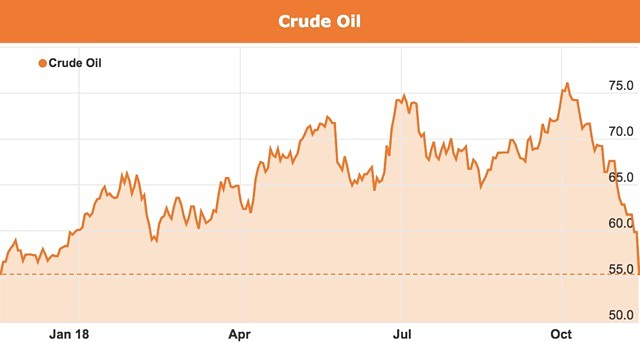Oil price plunges 28% amid uncertain production cutbacks and slowing demand

OPEC proposed this week to cut production by 1.4 million barrels per day from 2019 to try improve the oil price.
As oil prices drop to their lowest level in eight months, experts are warning of a rollercoaster ride ahead amid increasing worries about excess supply and sluggish demand.
On October 3, oil was sitting at a four year high of US$76.72, a month later and the West Texas Intermediate had plummeted to a one-year low of US$54.75 per barrel on Tuesday, signalling the worst day since September 2015 when crude sank below US$39/bbl for the first time in six years.
A massive 28.6% plunge in the oil price within weeks.
With oil supply forecast to grow much faster than demand, OPEC (the Organisation of Petroleum Exporting Countries) said in its monthly report that it expects orders for oil produced by its member nations will be about 31.5 million barrels per day next year – or 500,000 barrels per day lower than its September figure and about 1.4 million barrels per day below current production.
The cartel also cut its forecast for overall global oil demand growth by 70,000 barrels per day.
While the hints were strong that OPEC would lower its demand estimates and possibly announce a cutback to production this week, the speculation wasn’t helped by US President Donald Trump’s efforts to jump the gun and push back on any plans.
Hopefully, Saudi Arabia and OPEC will not be cutting oil production. Oil prices should be much lower based on supply!
— Donald J. Trump (@realDonaldTrump) November 12, 2018
“Hopefully, Saudi Arabia and OPEC will not be cutting oil production… Oil prices should be much lower based on supply!,” he tweeted on Tuesday, and immediately prices fell another 2%.
Saudi cutbacks
At the same time as OPEC was discussing its options, Saudi Arabia announced its intention to trim crude exports by as much as 500,000 barrels per day in December in an attempt to counteract the price slide.
The decision came less than two months after Saudi Energy Minister Khalid Al-Falih’s assurances that the kingdom would produce and export enough oil to keep prices steady.
The world’s top oil exporter has been pumping 10.7 million barrels per day since October.
Mr Al-Falih said production was boosted in November but nominations (or requests for a quantity of oil under a specific purchase or sales agreement) will be curtailed next month in a bid to bring stability back to the market.
“December nominations are 500,000 barrels per day less than November,” he said.
“Ideally we don’t like to cut – we will only cut if we see a persistent supply glut emerging.”
The market reacted well to the news and oil prices started their slow ascent but fell after the President’s tweet.
Iran sanctions
In early November, the US renewed its economic sanctions against Iran to curb the nation’s political and military activities across the Middle East.
The sanctions take aim at Iranian oil exports and threaten to exclude international companies from the US financial system if they do business with Iran’s oil players.
But the administration also granted six-month waivers to eight countries, including major buyers of Iranian crude such as China, India and Japan, allowing them to continue imports.
Iran’s reduced daily production rate of 1.3 million barrels per day combined with customer anticipation of the sanctions and the related search for sources of new supply, as well as the temporary waivers have done little to impact falling prices.
In fact, some oil experts say current world supplies are ample enough to keep the sanctions from driving prices higher.
OPEC control
As the main determinant of oil price fluctuations, the OPEC consortium comprises 14 countries and controls 40% of the world’s supply of oil.
The group sets production levels to meet global demand and can easily influence the price of oil and gas by increasing or decreasing production.
OPEC has a history of curbing its output to prop up prices, with the exception of 2014 when member nations failed to reach a consensus to cut production while prices crashed under the weight of oversupply mostly from unconventional (shale) drilling in the US.
For the four years prior, the group didn’t have to do much to keep prices over US$100 a barrel so when the 2014 meeting in Vienna rolled around, analysts expected OPEC to make production cuts and resolve prices.
But when the closely-watched meeting came to a close and the market learned of the decision, oil prices promptly nosedived.
By 2016 in the midst of a prolonged slide, OPEC finally agreed to decrease production from the start of 2017 from 33.8 million barrels a day to 32.5 million barrels per day.
Latest cuts
At an OPEC meeting in Abu Dhabi this week, talk revolved once again around cutting oil output, this time by a proposed 1.4 million barrels per day from 2019 in a bid to avert a glut which would further impact prices.
Despite President Trump’s tweet, OPEC members may approve the cut which would signal a turnaround to proceedings at the cartel’s September meeting where oil companies talked about pumping extra product into the market to help soothe increasing supply shock fears.

